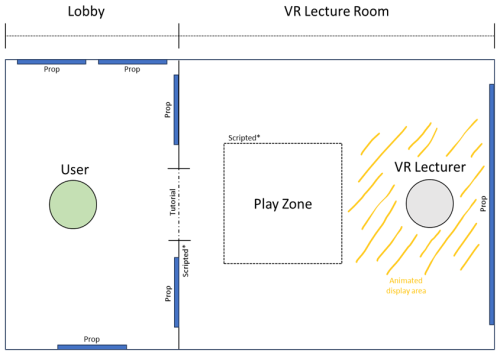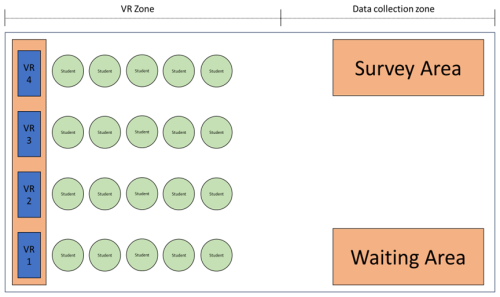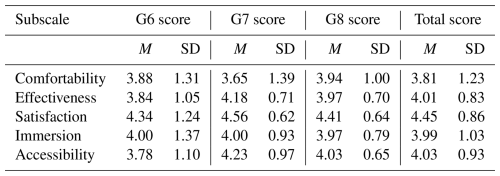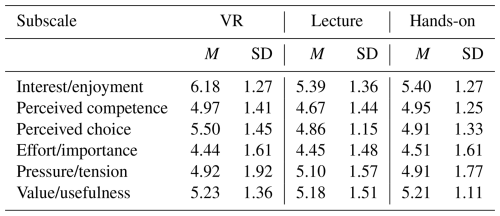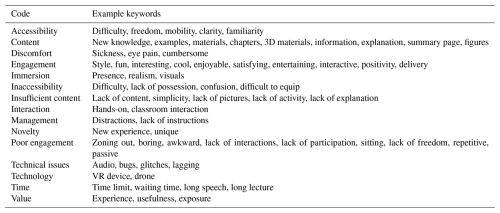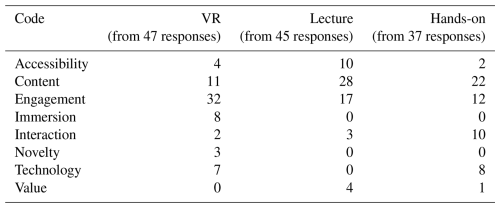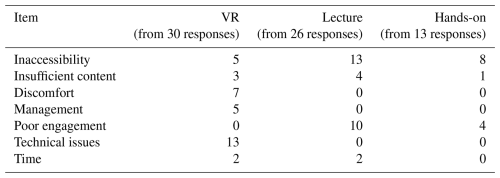the Creative Commons Attribution 4.0 License.
the Creative Commons Attribution 4.0 License.
Usability and motivational impact of a fast-paced immersive virtual-reality lecture on international middle-school students in geoscience education
Azim Zulhilmi
Yuichi S. Hayakawa
Daniel R. Newman
Immersive virtual reality (VR) offers educators an innovative tool to teach geoscience, addressing challenges in conveying the Earth's 3D characteristics, which have traditionally been taught through field visits and experiences that are often inaccessible to many due to socioeconomic, political, and logistical barriers. VR provides an alternative experience, allowing users to virtually explore geological sites beyond physical and situational constraints. Despite its potential, the implementation of geoscience-focused VR lectures remains largely unexplored. As a pioneering case study, this research investigates the usability and motivational impact of VR by developing a fast-paced virtual reality lecture on landslides for middle-school students. Approximately 60 students from diverse cultural and educational backgrounds participated. Results revealed that the VR lecture was usable, with key strengths being its ability to engage students and deliver satisfaction. Compared to traditional (lecture and hands-on) teaching methods, VR excelled in fostering interest, enjoyment, and perceived choice. This study provides valuable insights into the practical implementation of VR in geoscience education, demonstrating its potential to make geoscience topics more accessible and engaging for diverse student groups. Future research should explore strategies to address usability challenges and enhance the motivational attributes of VR, paving the way for its broader adoption in geoscience educational settings.
- Article
(1962 KB) - Full-text XML
-
Supplement
(341 KB) - BibTeX
- EndNote
Geoscience education can be referred to as structured teaching and learning that focuses on the Earth's physical features, processes, and systems. When teaching geoscience, it is important that students develop observational and spatial thinking skills, as it is an observational science. In particular, field experiences in geoscience require a level of thinking, mental visualization, and investigative skills not commonly found in other scientific fields (King, 2008; Liben et al., 2011). Therefore, it is necessary for educators of geoscience to emphasize transferring these key skills to their students.
Conventional geoscience teaching methods using textbooks and lectures often fail to effectively convey the reality of nature, including three-dimensional (3D) features of the Earth. These approaches tend to rely on pseudo-3D visualizations to express the Earth; this is challenging, as it places additional cognitive burden on learners to mentally visualize complex 3D geometrical concepts that they may not be very familiar with (Fitzpatrick and Hedley, 2024; Havenith et al., 2019). Hands-on activities, like fieldwork, museum visits, and lab activities, help address this limitation, but access is often restricted due to practical issues like finance, health, socioeconomic, and logistical barriers. Addressing these challenges is vital for advancing geoscience education for all.
Immersive virtual reality (VR) offers a promising solution to tackle this issue. VR provides an immersive, interactive, and realistic 3D experience accessible through head-mounted displays (HMDs) and their respective peripherals. It addresses the accessibility and visualization challenges of traditional geoscience teaching methods by enabling the fully immersive realistic exploration of geological data in 3D with intuitive motion-based interaction while also leveraging physical and cyber portability. Furthermore, it is well understood from meta-analyses studies and reviews that VR can yield student learning improvements at the elementary-, middle-, and high-school education levels (Merchant et al., 2014; Di Natale et al., 2020; Villena-Taranilla et al., 2022). This makes VR a potentially versatile and highly useful tool for geoscience education and communication.
1.1 Literature review
One of the major global challenges today is ensuring quality education, as outlined by Sustainable Development Goal 4 in United Nations (2015):
“Ensure inclusive and equitable quality education and promote lifelong learning opportunities for all” (p. 14).
The geoscience community has made significant strides in communicating geoscience to the broader public, thereby facilitating knowledge dissemination beyond the scientific community. While traditional communication methods, such as lectures, museums, and workshops, have been widely utilized, advancements in technology now provide more innovative outreach approaches.
Studies on 3D printing in geological education highlight its benefits: Gutierrez et al. (2023) demonstrated that 3D-printed models improve undergraduates' spatial and visualization skills while also enhancing understanding of geological structures. Similarly, Chenrai (2021) found that integrating 3D printing into geoscience curricula bolstered structural interpretation and spatial visualization abilities.
Virtual field trips (VFTs) are effective tools for geological outreach: Watson et al. (2022) found personal computer (PC)-based VFTs engaging for teaching physical volcanology through 3D visuals and videos. Tibaldi et al. (2020) described a VR approach using 3D digital outcrop models for teaching, learning, and research in volcanology and suggested that VR is capable of engaging the public and can be valuable for promoting environmental site protection and development. The work of de Paz-Álvarez et al. (2022) demonstrated VFTs' usefulness in teaching mapping skills but noted that they cannot fully replace traditional courses. Klippel et al. (2019) showed that immersive VFTs with VR headsets improved lab performance and enthusiasm compared to traditional field trips. Harknett et al. (2022) used VR for teaching students structural geology fieldwork skills in structurally complex volcanic terrains, noting its potential role in existing geoscience education curricula.
Other VR applications show promise in geoscience communication: Yamauchi et al. (2022) used VR to visualize underground heritage (Taya Caves in Yokohama, Japan), boosting interest and encouraging potential real-world visits. Alene et al. (2024) developed “QuickAware”, a VR tool raising awareness of quick clay landslides, effectively enhancing hazard understanding. Graebling et al. (2024) introduced “VR-EX”, a storyline-based VR application for learning geological electrical resistivity tomography experiments at Mont Terri underground laboratory (Switzerland), which fostered high engagement, immersion, and knowledge transfer. Jong et al. (2020) applied spherical video-based VR and found positive results with respect to its pedagogical effectiveness on teaching physical geography.
As these studies demonstrate, geoscience outreach methods are expanding beyond traditional methods with the integration of innovative technologies and concepts like 3D printing, VFTs, and immersive VR experiences. However, despite these growing strategies, a gap remains in evaluating the effectiveness of VR-based pedagogies (Jong et al., 2020; Harknett et al., 2022; Hagge, 2024), such as in formal geoscience education. Further contribution is necessary, especially with respect to integrating the lecture component of traditional geoscience education with VR. By combining the interactive nature of VR with the structured learning of lectures, a more dynamic and immersive approach to geoscience education could be achieved, potentially enhancing both engagement and knowledge retention while also ideally, improving communication to a wider audience.
1.2 Objectives
This paper explores the effectiveness of VR-based geoscience lectures in teaching middle-school students, addressing the limited focus on this demographic in VR-related geoscience research. Additionally, it offers an opportunity to introduce the students to geoscience concepts typically inaccessible at their educational level. The study emphasizes geoscience topics related to the 2018 Hokkaido Eastern Iburi Earthquake (HEIE). A fast-paced, portable VR lecture was developed for this purpose, and its effectiveness is compared to traditional teaching methods. To the authors' knowledge, this approach using VR lectures in geoscience education has not been explored before. This study is part of a larger project examining the feasibility of VR in geoscience education. In this paper, the focus is primarily on the motivational and usability aspects of the VR application.
Specifically, this study centres on the following key objectives:
- i.
evaluate the usability of a fast-paced VR lecture format and how it compares to the traditional teaching methods in terms of motivational preference by the participants at this educational level;
- ii.
explore the ability of the VR experience to incite interest and curiosity with respect to the geological environment;
- iii.
identify the strengths and limitations;
- iv.
outline potential directions for further development of such a teaching approach.
2.1 Participants and setting
The VR outreach programme was conducted on the morning of 19 September 2024 at Hokkaido International School (chosen for its diversity of students) and ran from 09:00 to 11:45 Japan Standard Time (JST). The session engaged middle-school students (11–14 years old) from grades 6 (G6) through 8 (G8) and included a total of 60 participants: 18 from G6, 21 from G7, and 21 from G8. The students came from a variety of international backgrounds, including East Asia, North America, Oceania, Europe, and Eurasia. This variety ensures that any bias toward a single perspective in the results is minimized. Hokkaido International School, a private institution, follows a Western-style education system with English as the medium of instruction.
The research workflow consists of three key stages: VR lecture development, survey formulation, and outreach execution. The VR lecture was designed to replicate traditional lectures within a VR environment while also leveraging VR-specific advantages, such as visualizing 3D VR models and the use of animated content. The survey aimed to evaluate middle-school students' motivation and usability experience of the VR lecture and to undertake a comparison between VR-based and traditional teaching methods. Traditional teaching methods refer to lecture and hands-on sessions. The entire outreach programme was strictly limited to 165 min by the school.
2.2 VR lecture development
The VR lecture had to adhere to time and participant number limitations. Furthermore, the goal was to fully leverage the unique capabilities of VR for presenting geoscience materials. To the best of the authors' knowledge, no existing applications met this specific need; therefore, it was seen as a requirement to develop a custom method that aligned with the principles of VR-based lectures.
This paper defines a VR lecture as such only when it meets at least the following key criteria:
-
delivered in a fully immersive 3D VR environment primarily accessed through immersive VR technology;
-
designed to teach in a structured manner with defined learning objectives;
-
conducted by a lecturer represented as an avatar, featuring a voice and expressive body language;
-
participants must have the ability to listen, visualize, navigate using VR-based locomotion, and engage with the lecture and its content within the virtual space;
-
incorporates teaching aids that are only possible in VR to enhance understanding;
-
capability of being adapted to various instructional settings.
Thus, the VR lecture was designed in the following manner: at the beginning, students spawned into the starting lobby and were guided to the lecture room after entering a doorway (Fig. 1a). After standing on a designated spot on the floor, the lecture commenced. The lecture featured a dummy virtual lecturer delivering a ∼ 5 min oral commentary on the geoscience topics (Fig. 1b). The lecture was fully voiced and showcased virtual teaching aids, including images, 360° photospheres, animated models, and a 1:1 scale field replica, to enhance understanding (Fig. 1c–f).
The 3D models were prepared using photogrammetry in Agisoft Metashape and 3D modelling in Blender. Voice lines were recorded using Microsoft's Windows Sound Recorder application. Unity game engine was used for implementing, animating, and displaying these assets, while VRChat served as the platform for hosting the lecture during the outreach day. The processing was performed on a desktop PC equipped with an RTX 3080 Ti graphics processing unit (GPU), an AMD Ryzen 5 7600X central processing unit (CPU), and 16 GB of random-access memory.
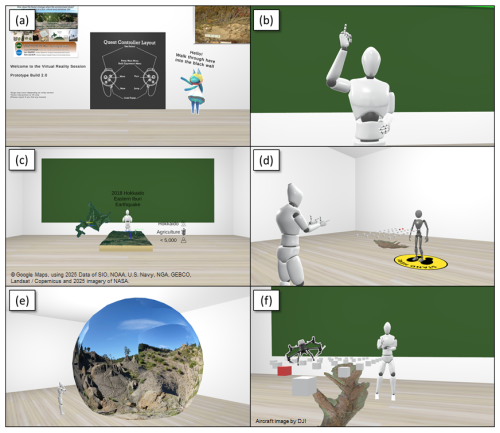
Figure 1World setting for the VR lecture: (a) the starting lobby room with tutorial board; (b) the VR lecturer; (c) the VR lecturer explaining about the 2018 HEIE; (d) a participant standing on the trigger zone; (e) the photosphere showcase of the deep-seated landslide; (f) the VR lecturer teaching about drones and 3D models.
During the prototype phase, which is critical for smooth implementation (Novotny et al., 2019), the VR lecture was tested on graduate students from Hokkaido University's Graduate School of Environmental Science. This process identified technical and content-related issues, allowing the team to refine and finalize the lecture experience. The resulting optimized blueprint was used for the outreach programme (Fig. 2).
2.3 Survey design
The survey design was inspired by the system usability scale (Brooke, 1996), which measures how easy a product is to use, and the intrinsic motivational inventory (Ryan and Deci, 2000), which measures the subjective user experience in relation to a specific target activity in laboratory experiments. These surveys have been used in previous studies (Carbonell-Carrera et al., 2021; Huang and Liu, 2024; Meulenbroeks et al., 2024).
The authors' version of the survey was modified for the prepared VR lecture scenario and adapted to accommodate the time constraints and number of students in the outreach programme. After the VR experience, students completed a 10 min survey consisting of the following sections (see the “Survey” Supplement file and Sects. S1–S3):
-
VR usability survey. This section assessed five categories – discomfort, effectiveness, satisfaction, immersion, and accessibility; using a five-point Likert scale.
-
VR/lecture/hands-on motivational survey. This section evaluated six categories – interest/enjoyment, perceived competence, perceived choice, effort/importance, pressure/tension, and value/usefulness; using a seven-point Likert scale.
-
Open comments. Students could provide feedback on positives and negatives as well as suggestions regarding the session.
To ensure reliable responses, Cronbach's alpha (Cronbach, 1951; Gliem and Gliem, 2003) was used, with interpretations based on thresholds from George and Mallery (2002) (≥ 0.9: excellent; ≥ 0.8: good; ≥ 0.7: acceptable; ≥ 0.6: questionable; ≥ 0.5: poor). The full questionnaires are provided in the Supplement.
2.4 Outreach approach
The outreach programme followed a structured schedule: an early-morning setup, student gathering and briefing, programme initiation, and survey data collection (Fig. 3). Equipment deployed included four HMDs (one Oculus Quest 2, one Meta Quest 2, and two Meta Quest 3 units) supported by an Oculus Link and three third-party link cables. Four laptop VR workstations (MSI GS65, HP OMEN, ASUS ROG Zephyrus G14, and HP ZBook Firefly 14 G8) were used, each running Windows OS with integrated CPUs and GPUs.
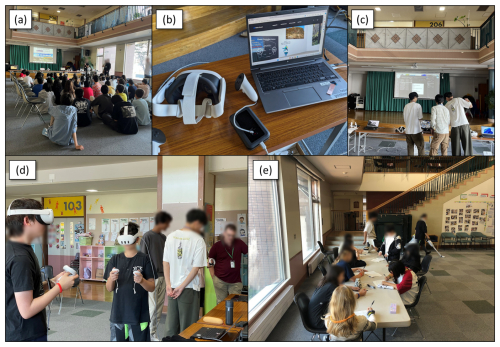
Figure 3Pictures of the VR outreach session: (a) students gathering for outreach briefing; (b) example of a VR workstation; (c) outreach staff setting up VR stations; (d) students at the VR stations; (e) the survey station.
The VR sessions were conducted based on the prepared floor plan (Fig. 4). Each session lasted 55 min, allowing for three rotations between the three sessions to fit within a total time frame of 165 min. The setup comprised four VR stations, a survey station, and a waiting area. Students were divided into four rows, with each experiencing the VR lecture for approximately 5 min before completing the surveys at the survey station (10 min). Those that completed the task moved to the waiting area.
In traditional-activity sessions, students participated in a standard face-to-face lecture, allowing them to listen to and interact with the instructor in a typical classroom setting. For the hands-on session, they engaged with 3D-printed models and even had the opportunity to watch and interact with the drones. The structure comprised 40 min allocated to activities or lectures and 15 min for surveys and transitions. This schedule enabled efficient coverage of all three grades within the allotted time, ensuring a streamlined outreach programme.
3.1 VR lecture usability
The overall Cronbach's alpha value for VR usability was 0.90, indicating excellent reliability. The VR lecture usability survey results were as follows (Table 1):
-
Comfortability scored 3.81 (standard deviation (SD) = 1.23), reflecting a positive (reverse-coded) outcome. This suggests that students disagreed with feeling discomfort during the 5 min VR lecture.
-
Effectiveness scored 4.01 (SD = 0.83), indicating a positive outcome. Students agreed that the VR lecture was easy to use and helped them understand the landslide and the authors' research.
-
Satisfaction scored 4.45 (SD = 0.86), showing an overwhelmingly positive outcome. Students strongly agreed that they were satisfied with the VR experience, enjoyed it, and would recommend it to others.
-
Immersion scored 3.99 (SD = 1.03), resulting in a positive outcome. Students agreed that they felt immersed in the experience and wanted to continue beyond the time limit.
-
Accessibility scored 4.03 (SD = 0.93), demonstrating a positive outcome. Students agreed that the VR application provided sufficient support and was easy to use, regardless of prior VR experience.
3.2 Motivational results
The overall Cronbach's alpha value for the VR lecture motivational survey was 0.88, indicating good reliability. The survey results are summarized below (Table 2):
-
Interest/enjoyment scored 6.18 (SD = 1.27), indicating an overwhelmingly positive outcome. Students strongly agreed that the VR activity was interesting and enjoyable.
-
Perceived competence scored 4.97 (SD = 1.41), showing a slightly positive outcome. Students slightly agreed that they understood the session, felt confident in their knowledge, and believed they performed better than their peers.
-
Perceived choice scored 5.50 (SD = 1.45), resulting in a positive outcome. Students agreed that they participated willingly and felt a sense of freedom during the activity.
-
Effort/importance scored 4.44 (SD = 1.61), indicating a slightly positive outcome (effort item reverse-coded). Students slightly agreed that they put effort into the session and found the activity meaningful.
-
Pressure/tension scored 4.92 (SD = 1.92), showing a slightly positive outcome (both items reverse-coded). Students slightly disagreed that the activity caused tension or anxiety.
-
Value/usefulness scored 5.23 (SD = 1.36), reflecting a slightly positive outcome. Students slightly agreed that the activity was valuable for their future and useful for enhancing geological knowledge, improving their motivation in geoscience.
Table 2VR motivational results for middle-school students.
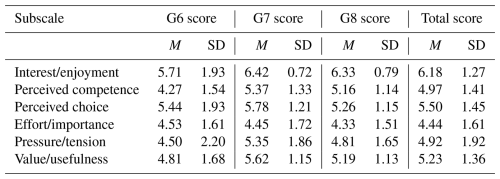
Note: G = grade; M = mean; SD = standard deviation.
The overall Cronbach's alpha value for the lecture session was 0.86, indicating good reliability. The survey results are summarized below (Table 3):
-
Interest/enjoyment scored 5.39 (SD = 1.36), indicating a positive outcome. Students agreed that the lecture was interesting and enjoyable.
-
Perceived competence scored 4.67 (SD = 1.44), showing a slightly positive outcome. Students slightly agreed that they understood the session, felt confident in their knowledge, and believed they performed better than peers.
-
Perceived choice scored 4.86 (SD = 1.15), resulting in a slightly positive outcome. Students slightly agreed that they participated willingly and felt some freedom in their choices.
-
Effort/importance scored 4.45 (SD = 1.48), indicating a slightly positive outcome (effort item reverse coded). Students slightly agreed that they invested effort and found the activity meaningful.
-
Pressure/tension. scored 5.10 (SD = 1.57), showing a slightly positive outcome (both item reverse coded). Students slightly disagreed that the session caused tension or anxiety.
-
Value/usefulness scored 5.18 (SD = 1.51), reflecting a slightly positive outcome. Students slightly agreed that the lecture was valuable for their future and useful for enhancing geological knowledge, improving their motivation in geoscience.
Table 3Lecture motivational results for middle-school students.

Note: G = grade; M = mean; SD = standard deviation.
The overall Cronbach's alpha value for the hands-on session was 0.95, demonstrating excellent reliability. On a seven-point Likert scale, the survey results are as follows (Table 4):
-
Interest/enjoyment scored 5.40 (SD = 1.27), indicating a positive outcome. Students agreed that the hands-on activity was interesting and enjoyable.
-
Perceived competence scored 4.95 (SD = 1.25), showing a slightly positive outcome. Students slightly agreed that they understood the session, felt confident in their knowledge, and believed they performed better than peers.
-
Perceived choice scored 4.91 (SD = 1.33), resulting in a slightly positive outcome. Students slightly agreed that they participated willingly and felt some freedom in their choices during the hands-on activity.
-
Effort/importance scored 4.51 (SD = 1.61), indicating a slightly positive outcome (effort item reverse coded). Students slightly agreed that they invested effort and found the activity meaningful.
-
Pressure/tension scored 4.91 (SD = 1.77), showing a slightly positive outcome (both item reverse coded). Students slightly disagreed that the session caused tension or anxiety.
-
Value/usefulness scored 5.21 (SD = 1.11), reflecting a slightly positive outcome. Students slightly agreed that the hands-on activity was valuable for their future and useful for enhancing geological knowledge, improving their motivation in geoscience.
Table 4Hands-on motivational results for middle-school students.
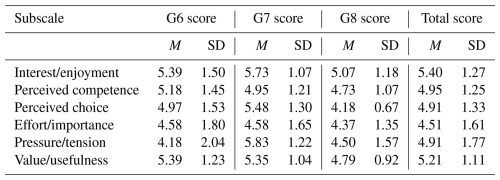
Note: G = grade; M = mean; SD = standard deviation.
Table 5 shows an overall comparison of the motivational impacts between the VR, lecture, and hands-on activity for all grades combined. The VR activity tends to score highest except for the effort/importance and pressure/tension metrics, while the hands-on activity often comes to the second.
3.3 Open comments
The open comments provided valuable insights into the positive and negative traits of each session as perceived by the participants. This information is not to be mistaken for concrete frequency data pertaining these traits; rather, it is only what was noticeable and mentioned by the participants. Student feedback ranged from single words to more detailed responses, which required the author to code the responses individually according to a keyword-based guideline (Table 6). The frequency of responses for each code reflects the traits that were most mentioned, highlighting the strongest impressions of the sessions. While even a single mention indicates a positive or negative trait, the most frequently cited elements point to the most prominent experiences of the participants.
In terms of positive aspects, the VR session received the most positive feedback with respect to its engagement, followed by the content, immersion, technology, accessibility, novelty, and interaction (Table 7). The lecture session was most appreciated for its content, with engagement, accessibility, value, and interaction also receiving positive mentions. Similarly, the hands-on session was praised for its content, engagement, and interaction, followed by technology, accessibility, and value. The primary takeaway from the VR session was its ability to engage students, while the lecture and hands-on sessions were most valued for their content.
On the other hand, the negative aspects identified in the feedback revealed areas for improvement. For the VR session, the most frequently mentioned negative aspects included technical issues, discomfort, inaccessibility/management, insufficient content, and time constraints (Table 8). For the lecture session, the main concerns were inaccessibility, poor engagement, insufficient content, and time limitations. The hands-on session received similar negative feedback, with inaccessibility, poor engagement, and insufficient content being the most common complaints. The key negative issue for the VR session was the presence of technical problems, while the lecture and hands-on sessions were predominantly affected by accessibility challenges.
4.1 VR usability impacts
Overall feedback on VR-related discomfort was positive (Table 1), with most middle-school students reporting no significant issues during the 5 min lecture. However, seven students experienced discomfort, including eye strain, headset heaviness, and motion sickness (Table 8). Motion sickness, or cybersickness, is a known challenge in VR adoption (Chang et al., 2020; Chattha et al., 2020; Keshavarz et al., 2011). The positive experience likely resulted from the short lecture duration, minimal movement, simple design, and optimized performance, all of which could have reduced discomfort triggers. Previous studies indicate that longer sessions, complex tasks, and unrealistic locomotion increase motion sickness risk due to sensory conflict (Dużmańska et al., 2018; Reason and Brand, 1975; Saredakis et al., 2020). By keeping the experience brief and straightforward, these issues were effectively minimized.
The effectiveness of the VR experience received positive feedback (Table 1), with students finding it easy to use, navigate, and effective for learning geoscience topics. The lecture was designed to be simple and time-efficient, requiring minimal interaction; students only needed to stand, look, and listen. Open comments confirmed that students gained new knowledge, with 3D models being particularly helpful for understanding and visualizing discussed concepts (Table 7). Research on penetrative thinking (Bagher et al., 2020) and spatial abilities (Gittinger and Wiesche, 2024) supports that VR can benefit low-spatial-ability learners. Therefore, strategically designed VR lectures with 3D models can enhance geoscience teaching and improve learning effectiveness.
The satisfaction category received overwhelmingly positive feedback, with students across all grades enjoying the VR experience (Table 1). Open comments emphasized the excitement of learning geoscience in an engaging way, enhanced by a variety of 3D geological examples (Table 7). Similar positive responses to VR in educational settings have been reported across age groups, from high school to university (Graebling et al., 2024; Visneskie et al., 2020; Yamauchi et al., 2022). These findings complement the literature, suggesting that VR is well received by students, even at the middle-school level.
The immersion category also received positive feedback, with students feeling absorbed and expressing a desire for longer VR sessions (Table 1). The VR lecture's immersive design, featuring a scripted virtual lecturer, detailed 3D content, and animations, likely enhanced this effect. Students highlighted the visuals, sense of “being there”, and freedom of movement as key contributors to their sense of immersion (Table 7). Similar findings have been observed in geological VR research, including simulations, role-playing, and visualization (Alene et al., 2024; Graebling et al., 2024; Klippel et al., 2019). These results support that VR effectively immerses students, fostering a sense of presence with the geoscience content.
The accessibility category received positive feedback, with students finding the VR lecture easy to use despite having no prior experience. The simple tutorial (hypothesized to pose some difficulties for students), featuring a single panel with basic instructions (Fig. 1a), was generally sufficient, although G6 students were more neutral, possibly needing additional guidance or time to consult it (see Table S1 in the Supplement). Some negative feedback pointed to the tutorial's simplicity and lack of detail (Table 8). This aligns with literature that has outlined the need for a robust familiarization phase (Harknett et al., 2022; Papadopoulou et al., 2022; Wright et al., 2023). While the current tutorial was adequate for most of the students, improvements for younger audiences, like G6, are recommended. Future studies should explore ways to enhance the tutorial or familiarization process for younger audiences.
Overall, the VR usability of this VR lecture experience was positive with a strong level of satisfaction; however, there is room for improvement regarding discomfort, immersion effectiveness, and accessibility, in order obtain a stronger positive sentiment.
4.2 VR motivational impacts
The VR session outperformed the lecture and hands-on sessions with respect to interest/enjoyment, receiving overwhelmingly positive feedback (Tables 2, 3, and 4). Its immersive 3D content and interactive experience led to strong engagement, with no reports of poor engagement. This aligns with similar studies in geoscience education (Graebling et al., 2024; Visneskie et al., 2020). However, critiques of the VR session primarily focused on its limited duration. Lectures and hands-on sessions were praised for content delivery, with lectures benefiting from teacher interaction and hands-on sessions excelling regarding interactivity. Traditional methods, however, faced issues like poor engagement and excessive session length (Table 8), which could induce boredom (Mann and Robinson, 2009). While VR's immersion is effective for engagement, the novelty may diminish with repeated use, warranting further studies.
All sessions showed slightly positive outcomes in perceived competence, with no significant preference among students (Tables 2, 3, and 4). Likely, VR's 3D models and immersive content supported comprehension and spatial reasoning (Bagher et al., 2020; Gittinger and Wiesche, 2024). Students reported that VR aided the mental visualization of geological concepts, although the absence of subtitles, lack of interactivity, and fast pacing affected younger (G6) students. Lectures achieved positive outcomes with respect to their content and clarity, but some students desired more in-depth clarifications. Hands-on sessions benefited from interactive 3D models and drones, but students occasionally struggled with complex content. To improve confidence and comprehension, the VR activity could incorporate aiding elements (e.g. subtitles), interactive features, and slower pacing, while adjusting content based on the grade level.
Perceived choice was rated positively for all sessions, with VR slightly outperforming others (Tables 2, 3, and 4). Students appreciated VR's novelty and the freedom to explore models from different angles. Individual presence in virtual worlds can foster a sense of freedom and agency, allowing users to explore and interact with objects in ways impossible in the physical world (Chirico et al., 2018). Lectures offered interaction with instructors, and hands-on sessions excelled with respect to exploration and drone demonstrations. VR's lower score in this category stemmed from limited content, non-interactive models, and short session durations; this was compounded by having only four VR stations. VR's high cost could limit classroom implementation if resources are scarce. Nonetheless, VR's immersive environment provided a unique sense of autonomy, motivating engagement and fostering independence. Longer, more interactive sessions are recommended, possibly by increasing the VR workstation availability.
All sessions received slightly positive outcomes for effort/importance, indicating slight importance without being too demanding with respect to effort (Tables 2, 3, and 4). VR was praised for simplifying content with 3D materials, but it may have been seen more as a fun tool than a serious learning medium, reducing its perceived importance (Table 7). However, this fun factor may be important, as it will encourage exploration that could lead to a feeling of self-ownership in learning (Paige et al., 2024). Lectures were appreciated for clear explanations and future potential relevance, while hands-on sessions excelled with respect to interactivity but likely required more effort to understand the small-scale geology models. Emphasizing educational value in VR and incorporating more detailed interactive elements could enhance perceived effort and relevance.
Pressure/tension outcomes were slightly positive across all sessions, reflecting minimal stress or anxiety (Tables 2, 3, and 4). VR's immersive environment and low complexity may contribute to a relaxed experience, and this aligns with research on virtual presence (Pavic et al., 2023). However, issues like peer interference and the 5 min time limit occasionally caused frustration. Lectures and hands-on sessions benefited from engaging materials and supportive instructors, although content density with complexity could have contribute to increased perceived tension. Addressing timing, peer distractions, and content difficulty may reduce pressure and improve the perception of the VR lecture.
Finally, all sessions scored slightly positively for value/usefulness, with students recognizing benefits in geoscience knowledge and motivation but not finding them highly impactful (Tables 2, 3, and 4). VR was praised for enhancing visualization of landslides through 3D models, but the short duration and limited real-world applications diminished its impact. Lectures were valued for content and clarity, while hands-on sessions excelled with respect to interactivity. The entertainment-oriented perception of VR, stemming from its origins in the entertainment industry (Havenith et al., 2019; Hornsey and Hibbard, 2024), may have influenced their perception outcomes. Future studies should connect geoscience concepts to practical applications and try to extend VR session durations to increase perceived value and usefulness.
4.3 Advantages and disadvantages of the VR lecture
This study revealed that there are several advantages and disadvantages to delivering VR lectures in a school setting, most evident from the open-comment entries by the participants (Tables 7 and 8) and the results of the survey (Tables 1, 2, 3, and 4).
The project demonstrated VR's advantages for geoscience education. The fast-paced VR lecture was enough to engage middle-school students, showcasing its ability to attract and motivate effectively. Its short duration minimized VR-related discomfort. Its immersive nature offered a safe exploration of hazardous sites, enhanced understanding through 3D models, and bridged abstract and practical concepts not easily achievable through traditional means. Additionally, the novelty of VR technology in the geoscience curriculum excited and appealed to the students, while the freedom to explore the virtual environment, including free-roaming capabilities and interaction with the VR system, further enriched their learning experience.
Despite its strengths, the VR lecture presented several challenges. Although majority of students did not experience discomfort, there were still some that did (e.g. motion sickness, eye strain, HMD weight), and technical issues like individuals changing audio on shared headsets, glitches, and lag were common. VR experience can also vary depending on the developers' expertise, time, and budget, posing a potential challenge for standardized implementation. Moreover, VR is not yet widely adopted in current educational settings and requires time for users to learn the system for efficient usage. High costs limit headset availability, necessitating shared use, which leads to shorter sessions and extended wait times. Although VR can significantly improve accessibility for individuals with impaired mobility by offering virtual experiences that eliminate physical barriers, it remains largely unusable for individuals with highly impaired vision (those that cannot be fixed with prescription lenses), those with certain neurological or vestibular conditions, and those who cannot afford these devices due to financial limitations. Addressing these issues requires thoughtful planning, resources, and financial support especially considering implementation for quality and accessible geoscience education.
It should be noted that developing VR-based educational materials can be a time- and effort-intensive process that is quite unlike traditional lecture preparation. Practitioners looking into tackling such a topic may currently require some proficiency in game/3D engines, troubleshooting, user testing, the iterative refinement process, and sufficient knowledge of the geoscience subject matter for successful development of VR geoscience educational materials. These invisible workloads have been highlighted as difficulties inherent to VR approaches in prior research (Lütjens et al., 2019; Akbulut and Anani, 2023; Novotny et al., 2019).
The time and cost factor may be a significant barrier to global adoption of VR lectures in geoscience education. For example, creating and editing 3D data can be technically demanding and time-consuming for geoscience researchers and educators who may not have advanced computational expertise, and financial constraints often limit access to high-performance computers and HMD devices. However, this technology can offer additional benefits that traditional methods often struggle to deliver, as discussed (e.g. taking young students to dangerous field sites and various data presentation possibilities). Even if both VR and traditional methods yield a similar learning gain in the short term, the long-term impact of VR should also be considered, such as improved retention, increased motivation, and the ability to intuitively grasp complex spatial relationships of geological subjects, and may justify the additional time and cost. Furthermore, as VR development tools for geosciences become more standardized and user-friendly and the cost of necessary VR devices continues to decrease, the initial investment in content creation may be repaid over repeated use, making it a potentially viable long-term educational strategy. Further research is still required for more definitive conclusions, leading to the next section.
4.4 Limitations of the approach and recommendations for future work
It is advised that readers understand the limitations of this work, as this will be helpful when using it as a reference.
Researcher bias could influence the interpretation of qualitative open comments, despite adherence to coding guidelines (Table 6), as student responses varied from vague to detailed. Additionally, the sample may exhibit some class bias, as the school is a private institution catering primarily to foreign clients. Furthermore, session delivery styles differed among chairs, potentially affecting student experiences. Additionally, the survey was adapted for a young audience and time constraints, limiting its comprehensiveness; future studies with fewer constraints could address this. Moreover, while the sample was international, it lacked true global representation. These difference in a countries' learning culture may influence how individuals learn (Joy and Kolb, 2009). Also, not all students completed the questionnaire, especially the open-comment sections, due to factors like unwillingness to provide feedback or logistical issues. Although the VR session had the highest response rate, no session achieved full participation. Lastly, the study's fast-paced design, while efficient for collecting data, compromised the survey depth and the VR experience quality, which could have been enhanced with additional time.
Future research should expand the sample to include more countries, capturing cultural differences and offering a broader global perspective. Investigating the perceptions of students with extensive VR experience could provide insights into how familiarity influences outcomes, potentially through repeated-exposure experiments to mitigate the novelty effect over time. Another promising avenue is testing VR in multiplayer settings, where students collaborate to learn geological concepts. Additionally, live, teacher-led VR lectures could be compared with scripted formats to explore how educators adapt to VR and how students benefit versus traditional methods. Hybrid approaches, combining traditional and VR-based learning, also warrant further exploration.
This study developed a 5 min, fast-paced, automated VR lecture to evaluate its usability and motivational impacts on international middle-school students learning geological topics. To the best of the authors' knowledge, it is the first known attempt to assess VR-based geoscience lectures for this demographic; moreover, it showcases an efficient method for gathering substantial data within a limited time frame. Results demonstrated that the VR lecture was usable, with students reporting high satisfaction levels. Motivational impacts were positive, with the session excelling with respect to fostering interest and enjoyment as well as perceived choice. Overall, students showed a clear motivational preference for VR when compared to the traditional teaching methods.
Regardless of these results, the requirement remains for more potential improvements in the VR lecture architecture, particularly with respect to further enhancing its usability and motivational aspects. Future research should address the limitations identified in this study to achieve a consistently strong verdict across all survey categories. Additionally, insights from challenges in traditional teaching methods can also be used to guide the further refinement of VR implementation in middle-school education. This study highlights the potential of VR as a prospective platform for engaging diverse audiences and disseminating geoscientific knowledge.
The expanded versions of the data and surveys used in this study are available in the Supplement.
The supplement related to this article is available online at https://doi.org/10.5194/gc-8-197-2025-supplement.
All authors contributed to the study conception, design, material preparation, and data collection. The first draft of the manuscript was written by AZ, and all authors commented on previous versions of the manuscript. All authors read and approved the final manuscript.
The contact author has declared that none of the authors has any competing interests.
This study was conducted with consent from the head of school, adhering to ethical guidelines. Any personal data collected was anonymized, and participation was voluntary, prioritizing students' well-being and educational benefit.
Publisher’s note: Copernicus Publications remains neutral with regard to jurisdictional claims made in the text, published maps, institutional affiliations, or any other geographical representation in this paper. While Copernicus Publications makes every effort to include appropriate place names, the final responsibility lies with the authors.
The authors would like to acknowledge support from the Ministry of Education, Culture, Sports, Science and Technology (MEXT) of the Japanese government in the form of a scholarship that sponsored this study. The authors extend their gratitude to Tim Schlosser (head of school), Nick Fazio and Tricia Calhoon (middle-school teachers), and the dedicated staff members of the school, for their invaluable support and coordination with respect to successfully initiating this project. The authors also gratefully acknowledge the valuable assistance provided by students Masafumi Inomata, Tomoki Onodera, and Shunsaku Matsumura. Finally, the authors would like to express their sincere gratitude to the reviewers and the editor for their valuable feedback and insightful comments, which greatly contributed to the improvement of the manuscript.
This work has been partially supported by the Japan Society for the Promotion of Science (JSPS; KAKENHI grant nos. JP23K20541, JP21H00627, JP23KF0180, and JSPS bilateral programme no. JPJSBP120233201) and the 2023 Hokkaido University COI-NEXT fund.
This paper was edited by Jenna Sutherland and reviewed by Liam Taylor and Lynda Yorke.
Akbulut, N. and Anani, A.: Application of virtual reality in the mining industry – where we are now?, Preprint 23-036, paper presented at the SME Annual Conference, Denver, CO, https://me.smenet.org/application-of-virtual-reality-in/ (last access: 6 May 2025), 2023.
Alene, G. H., Depina, I., Thakur, V., Perkis, A., and Bruland, O.: QuickAware: A virtual reality tool for quick clay landslide hazard awareness, Nat. Hazards, 120, 1869–1898, https://doi.org/10.1007/s11069-023-06274-6, 2024.
Bagher, M. M., Sajjadi, P., Carr, J., La Femina, P., and Klippel, A.: Fostering penetrative thinking in geosciences through immersive experiences: a case study in visualizing earthquake locations in 3D, in: 2020 6th International Conference of the Immersive Learning Research Network (iLRN), 132–139, https://doi.org/10.23919/iLRN47897.2020.9155123, 2020.
Brooke, J.: SUS: A “Quick and Dirty” Usability Scale, in: Usability Evaluation In Industry, CRC Press, ISBN 9780429157011, 1996.
Carbonell-Carrera, C., Saorin, J. L., and Melián Díaz, D.: User VR Experience and Motivation Study in an Immersive 3D Geovisualization Environment Using a Game Engine for Landscape Design Teaching, Land, 10, 492, https://doi.org/10.3390/land10050492, 2021.
Chang, E., Kim, H. T., and Yoo, B.: Virtual Reality Sickness: A Review of Causes and Measurements, Int. J. Hum.-Comput. Interact., 36, 1658–1682, https://doi.org/10.1080/10447318.2020.1778351, 2020.
Chattha, U. A., Janjua, U. I., Anwar, F., Madni, T. M., Cheema, M. F., and Janjua, S. I.: Motion Sickness in Virtual Reality: An Empirical Evaluation, IEEE Access, 8, 130486–130499, https://doi.org/10.1109/ACCESS.2020.3007076, 2020.
Chenrai, P.: Case study on Geoscience Teaching Innovation: Using 3D Printing to Develop Structural Interpretation Skill in Higher Education Levels, Front. Earth Sci., 8, 590062, https://doi.org/10.3389/feart.2020.590062, 2021.
Chirico, A., Ferrise, F., Cordella, L., and Gaggioli, A.: Designing Awe in Virtual Reality: An Experimental Study, Front. Psychol., 8, 2351, https://doi.org/10.3389/fpsyg.2017.02351, 2018.
Cronbach, L. J.: Coefficient alpha and the internal structure of tests, Psychometrika, 16, 297–334, https://doi.org/10.1007/BF02310555, 1951.
de Paz-Álvarez, M. I., Blenkinsop, T. G., Buchs, D. M., Gibbons, G. E., and Cherns, L.: Virtual field trip to the Esla Nappe (Cantabrian Zone, NW Spain): delivering traditional geological mapping skills remotely using real data, Solid Earth, 13, 1–14, https://doi.org/10.5194/se-13-1-2022, 2022.
Di Natale, A. F., Repetto, C., Riva, G., and Villani, D.: Immersive virtual reality in K-12 and higher education: A 10-year systematic review of empirical research, Br. J. Educ. Technol., 51, 2006–2033, https://doi.org/10.1111/bjet.13030, 2020.
Dużmańska, N., Strojny, P., and Strojny, A.: Can Simulator Sickness Be Avoided? A Review on Temporal Aspects of Simulator Sickness, Front. Psychol., 9, 2132, https://doi.org/10.3389/fpsyg.2018.02132, 2018.
Fitzpatrick, M. and Hedley, N.: Review of the state of practice in geovisualization in the geosciences, Front. Earth Sci., 11, 1230973, https://doi.org/10.3389/feart.2023.1230973, 2024.
George, D. and Mallery, P.: SPSS for Windows step by step: A simple guide and reference, 11.0 update, 4th Edn., Allyn & Bacon, ISBN-13 978-0205375523, 2002.
Gittinger, M. and Wiesche, D.: Systematic review of spatial abilities and virtual reality: the role of interaction, J. Eng. Educ., 113, 919–938, https://doi.org/10.1002/jee.20568, 2024.
Gliem, J. A. and Gliem, R. R.: Calculating, Interpreting, and Reporting Cronbach's alpha Reliability Coefficient for Likert-Type Scales, in: 2003 Midwest Research to Practice Conference in Adult, Continuing, and Community Education, Columbus, 82–88, https://hdl.handle.net/1805/344 (last access: 11 January 2025), 2003.
Graebling, N., Ziefle, G., Furche, M., Nicol, R., Schefer, S., Ziegler, M., Jaeggi, D., Nussbaum, C., Annanias, Y., Goldstein, S., and Rink, K.: VR-EX – An immersive virtual reality serious game for science communication about the electrical resistivity tomography measurements in the Mont Terri Rock Laboratory, Switzerland, Environ. Earth Sci., 83, 318, https://doi.org/10.1007/s12665-024-11613-2, 2024.
Gutierrez, J., Akciz, S. O., Bursztyn, N., Nichols, K., and Thurmond, J.: Testing the efficacy of 3D-printed geologic models as tools for fostering spatial visualization abilities, Int. Geol. Rev., 65, 1320–1330, https://doi.org/10.1080/00206814.2022.2084647, 2023.
Hagge, P. D.: Metaverse in the geography lecture classroom? evaluating “group VR” possibilities using the multiplayer “Wooorld” VR app, J. Geogr. High. Educ., 48, 864–872, https://doi.org/10.1080/03098265.2024.2333290, 2024.
Harknett, J., Whitworth, M., Rust, D., Krokos, M., Kearl, M., Tibaldi, A., Bonali, F. L., Van Wyk De Vries, B., Antoniou, V., Nomikou, P., Reitano, D., Falsaperla, S., Vitello, F., and Becciani, U.: The use of immersive virtual reality for teaching fieldwork skills in complex structural terrains, J. Struct. Geol., 163, 104681, https://doi.org/10.1016/j.jsg.2022.104681, 2022.
Havenith, H.-B., Cerfontaine, P., and Mreyen, A.-S.: How virtual reality can help visualise and assess geohazards, Int. J. Digit. Earth, 12, 173–189, https://doi.org/10.1080/17538947.2017.1365960, 2019.
Hornsey, R. L. and Hibbard, P. B.: Current Perceptions of Virtual Reality Technology, Appl. Sci., 14, 4222, https://doi.org/10.3390/app14104222, 2024.
Huang, H. and Liu, G.: Evaluating students' behavioral intention and system usability of augmented reality-aided distance design learning during the COVID-19 pandemic, Univers. Access Inf. Soc., 23, 1217–1231, https://doi.org/10.1007/s10209-022-00920-9, 2024.
Jong, M. S., Tsai, C., Xie, H., and Kwan-Kit Wong, F.: Integrating interactive learner-immersed video-based virtual reality into learning and teaching of physical geography, Br. J. Educ. Technol., 51, 2064–2079, https://doi.org/10.1111/bjet.12947, 2020.
Joy, S. and Kolb, D. A.: Are there cultural differences in learning style?, Int. J. Intercult. Relat., 33, 69–85, https://doi.org/10.1016/j.ijintrel.2008.11.002, 2009.
Keshavarz, B., Hecht, H., and Zschutschke, L.: Intra-visual conflict in visually induced motion sickness, Displays, 32, 181–188, https://doi.org/10.1016/j.displa.2011.05.009, 2011.
King, C.: Geoscience education: An overview, Stud. Sci. Educ., 44, 187–222, https://doi.org/10.1080/03057260802264289, 2008.
Klippel, A., Zhao, J., Jackson, K. L., La Femina, P., Stubbs, C., Wetzel, R., Blair, J., Wallgrün, J. O., and Oprean, D.: Transforming Earth Science Education Through Immersive Experiences: Delivering on a Long Held Promise, J. Educ. Comput. Res., 57, 1745–1771, https://doi.org/10.1177/0735633119854025, 2019.
Liben, L. S., Kastens, K. A., and Christensen, A. E.: Spatial Foundations of Science Education: The Illustrative Case of Instruction on Introductory Geological Concepts, Cogn. Instr., 29, 45–87, https://doi.org/10.1080/07370008.2010.533596, 2011.
Lütjens, M., Kersten, T., Dorschel, B., and Tschirschwitz, F.: Virtual reality in Cartography: Immersive 3D Visualization of the Arctic Clyde Inlet (Canada) Using Digital Elevation Models and Bathymetric Data, Multimodal Technol. Interact., 3, 9, https://doi.org/10.3390/mti3010009, 2019.
Mann, S. and Robinson, A.: Boredom in the lecture theatre: An investigation into the contributors, moderators and outcomes of boredom amongst university students, Br. Educ. Res. J., 35, 243–258, https://doi.org/10.1080/01411920802042911, 2009.
Merchant, Z., Goetz, E. T., Cifuentes, L., Keeney-Kennicutt, W., and Davis, T. J.: Effectiveness of virtual reality-based instruction on students' learning outcomes in K-12 and higher education: a meta-analysis, Comput. Educ., 70, 29–40, https://doi.org/10.1016/j.compedu.2013.07.033, 2014.
Meulenbroeks, R., Van Rijn, R., and Reijerkerk, M.: Fostering Secondary School Science Students' Intrinsic Motivation by Inquiry-based Learning, Res. Sci. Educ., 54, 339–358, https://doi.org/10.1007/s11165-023-10139-0, 2024.
Novotny, J., Tveite, J., Turner, M. L., Gatesy, S., Drury, F., Falkingham, P., and Laidlaw, D. H.: Developing Virtual Reality Visualizations for Unsteady Flow Analysis of Dinosaur Track Formation using Scientific Sketching, IEEE Trans. Vis. Comput. Graph., 25, 2145–2154, https://doi.org/10.1109/TVCG.2019.2898796, 2019.
Paige, C., Haddad, D. D., Piercy, T., Todd, J., Ward, F., Ekblaw, A., and Newman, D.: Development and user study of the Operational Geology in a Virtual Environment (OGIVE) platform, Acta Astronaut., 224, 17–36, https://doi.org/10.1016/j.actaastro.2024.07.043, 2024.
Papadopoulou, E.-E., Papakonstantinou, A., Kapogianni, N.-A., Zouros, N., and Soulakellis, N.: VR Multiscale Geovisualization Based on UAS Multitemporal Data: The Case of Geological Monuments, Remote Sens., 14, 4259, https://doi.org/10.3390/rs14174259, 2022.
Pavic, K., Chaby, L., Gricourt, T., and Vergilino-Perez, D.: Feeling Virtually Present Makes Me Happier: The Influence of Immersion, Sense of Presence, and Video Contents on Positive Emotion Induction, Cyberpsychol. Behav. Soc. Netw., 26, 238–245, https://doi.org/10.1089/cyber.2022.0245, 2023.
Reason, J. T. and Brand, J. J.: Motion sickness, Academic Press, ISBN-13 978-0125840507, 1975.
Ryan, R. M. and Deci, E. L.: Self-determination theory and the facilitation of intrinsic motivation, social development, and well-being, Am. Psychol., 55, 68–78, https://doi.org/10.1037/0003-066X.55.1.68, 2000.
Saredakis, D., Szpak, A., Birckhead, B., Keage, H. A. D., Rizzo, A., and Loetscher, T.: Factors Associated With Virtual Reality Sickness in Head-Mounted Displays: A Systematic Review and Meta-Analysis, Front. Hum. Neurosci., 14, 96, https://doi.org/10.3389/fnhum.2020.00096, 2020.
Tibaldi, A., Bonali, F. L., Vitello, F., Delage, E., Nomikou, P., Antoniou, V., Becciani, U., Van Wyk de Vries, B., Krokos, M., and Whitworth, M.: Real world–based immersive Virtual Reality for research, teaching and communication in volcanology, Bull. Volcanol., 82, 38, https://doi.org/10.1007/s00445-020-01376-6, 2020.
United Nations: Transforming our world: The 2030 agenda for sustainable development (A/RES/70/1), United Nations General Assembly, https://undocs.org/A/RES/70/1 (last access: 26 December 2024), 2015.
Villena-Taranilla, R., Tirado-Olivares, S., Cózar-Gutiérrez, R., and González-Calero, J. A.: Effects of virtual reality on learning outcomes in K-6 education: A meta-analysis, Educ. Res. Rev., 35, 100434, https://doi.org/10.1016/j.edurev.2022.100434, 2022.
Visneskie, H., Parks, J., and Johnston, J.: Learning about Ontario's Paleozoic Geology with Virtual Reality Google Expedition Tours, http://hdl.handle.net/10012/15693 (last access: 11 January 2025), 2020.
Watson, A., Kennedy, B. M., Jolley, A., Davidson, J., and Brogt, E.: Design, implementation, and insights from a volcanology Virtual Field Trip to Iceland, Volcanica, 5, 451–467, https://doi.org/10.30909/vol.05.02.451467, 2022.
Wright, P. N., Whitworth, M., Tibaldi, A., Bonali, F., Nomikou, P., Antoniou, V., Vitello, F., Becciani, U., Krokos, M., and Van Wyk De Vries, B.: Student evaluations of using virtual reality to investigate natural hazard field sites, J. Geogr. High. Educ., 47, 311–329, https://doi.org/10.1080/03098265.2022.2045573, 2023.
Yamauchi, H., Tsuruoka, K., Ogura, T., Tamura, Y., Hayakawa, Y. S., Iizuka, K., and Oguchi, T.: Development and evaluation of an application for exploring historical sites using three-dimensional geospatial data and Virtual Reality technology: a contribution to geography education, E-Journal Geo, 17, 169–179, https://doi.org/10.4157/ejgeo.17.169, 2022.





